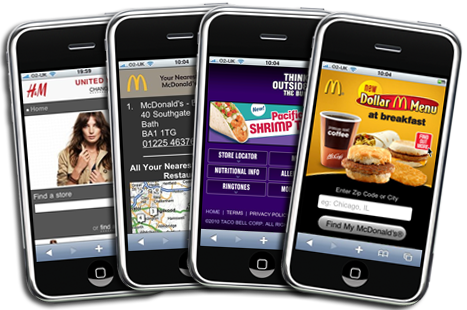Tips For Creating a Mobile Website

Everywhere you look these days you can find people on their smartphones. In airports, restaurants, on the subway, at the movie theatre, at concerts; the list goes on. The fact is that 91% of all adults in the U.S. have a smartphone, and 75% of them have used their mobile device to shop. Also, smartphone sales have now officially passed computer sales. So if you don’t have a website that is mobile friendly, you are missing outon all these possible customers and clients! You may have a website right now that works perfectly fine, but if it is not optimized for mobile, your possible client base is drastically smaller. Don’t let this happen to you! Go mobile with your website today and capture those customers you wouldn’t be able to reach normally!
If you’re just starting out with the mobile movement, don’t worry, we’ve compiled a list of tips for when you start building your mobile site.
Keep Navigation Simple
Don’t confuse visitors with unnecessary information. Make sure your homepage is direct, concise, and provides information that a customer would want on the go such as your company’s phone number, address, hours of operation, and directions. You also want to ensure that any buttons or links you provide are big enough so that touchscreen users can click through without any hassle. The last thing you want to remember to do is place your contact information high enough on the page so that your visitors don’t have to search for them. You want your contact information to be easily accessible since that is one of the main reasons people will come to your mobile site.
Keep Scrolling To A Minimum
Sometimes when you visit a site that isn’t mobile optimized, you have to pinch, squeeze, and scroll just to see the information you want. Navigating from left to right can be especially annoying for end users. So when you are designing your mobile optimized webpage, you want to eliminate this. Ideally, you want to align all of your content into a single, vertical column so that visitors only have to move in two directions, up and down, when using your mobile site. If you feel you still have a lot more information to present, you can consider implementing a collapsible menu which would allow users to click on the content they desire and the rest would be hidden. Either way, you want to keep movement on the end user’s part to a minimum.
Keep Your Images and Graphics Simple and Small
Remember, you are designing a mobile site, not a desktop site. The grand images that you have on your current desktop site will probably not be a good idea on your mobile site. Having too many big, bold, and beautiful images sounds nice, but it will become burdensome on the site and will slow your pages’ load times. If images are a large part of showing what you and your company do, then you might want to condense or resize your images so that they work better for mobile devices. You can still provide a link to your main site if you feel customers might want to wait it out and look at your original images anyway.
Limit Keystrokes
If you haven’t noticed already, keeping it simple is the major theme when designing a mobile website. In fact, it’s pretty much a rule of thumb that you want to keep it as simple as you possibly can without compromising key content. To go along with this, you want to avoid creating long forms for visitors to fill out. Anything that requires a lot of typing becomes tiresome for mobile users. They don’t want to type on their mobile devices, they want to click. If your site is e-commerce enabled, only require customers to provide information that you absolutely need to complete the deal. An alternative option you could use is having users register on your main site first, so that you have their payment information and only need to ask for their username and password when they purchase something on their mobile device. If none of these work, you can always make it easy for visitors to find your phone number so they can just call you and place an order.
Make Your Call-To-Actions Visible
If you want visitors to your site to do something, make it easy for them! Any call-to-action (CTA) that you design for your site, you want to make prominent on the site. If users aren’t clicking on your CTAs, that means they aren’t designed very well, or they simply are not visible enough. Make sure your CTAs are visible or you will not see actions on the part of the consumer!
Link To Your Main Website
We mentioned this earlier, but linking to your main site is important for a number of reasons. Sometimes visitors to your site will want to navigate your main site as opposed to your mobile site, simply because of their personal preference. Other times, visitors may be looking for something that you could not provide on your mobile site, but can be found on your main site. The best place to put your main site link is usually in the footer. That is where most visitors will expect to find it.
If You Need Help, Get It
Building a mobile site can be difficult if you’re a newbie. But don’t worry, there are experts out there who can help you. We here at Anchor Mobile have all of the tools and platforms you would need to successfully set up, test, and implement a mobile website. Plus, we have extensive experience in the field and have seen what works and what doesn’t. Considering mobile marketing has virtually exploded over the last 3-5 years, NOW is the time when you want to start integrating mobile marketing into your marketing campaign. If you don’t go mobile with your website soon, you will lose out to your competition that HAS gone mobile. Don’t let this happen to you! Go mobile TODAY and see how much mobile has to offer you and your company!








Leave a Reply
Want to join the discussion?Feel free to contribute!